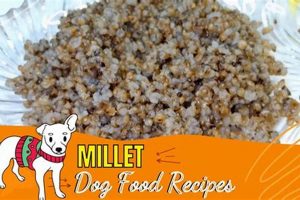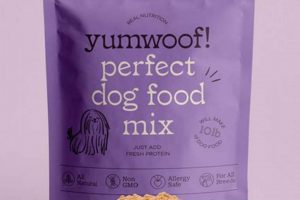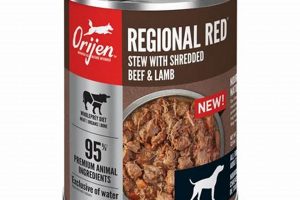Food formulated to meet the elevated caloric needs of active canines, working dogs, or those requiring weight gain is designed to provide a concentrated source of fuel. These specialized diets typically feature increased levels of protein and fat compared to standard maintenance formulas. For example, a sled dog during racing season requires significantly more calories than a typical house pet, and specialized food addresses this demand.
Meeting the increased nutritional demands of highly active animals is essential for maintaining optimal performance, muscle mass, and overall health. Historically, owners of working dogs have relied on supplementing regular feed with extra meat or fats. Modern formulations offer a more balanced and complete approach, minimizing the risk of nutrient deficiencies and ensuring appropriate levels of essential vitamins and minerals. This helps to prevent muscle loss and maintain stamina.
The following sections will delve into specific components of these specialized diets, examining the roles of protein, fats, and carbohydrates, along with factors influencing the selection of a suitable product, and potential considerations for specific canine health conditions.
Considerations for High Energy Canine Diets
Selecting appropriate nourishment for dogs with elevated activity levels requires careful consideration of several factors. The following recommendations provide guidance in choosing a suitable dietary regimen.
Tip 1: Evaluate Activity Level: Assess the dogs daily physical exertion. Working dogs, athletes, or those with extremely active lifestyles necessitate higher caloric intake compared to moderately active pets. Quantify energy expenditure to guide food selection.
Tip 2: Prioritize Protein Content: Higher protein levels are crucial for muscle maintenance and repair in active dogs. Opt for formulas with a significant percentage of animal-based protein sources, ensuring essential amino acids are readily available.
Tip 3: Analyze Fat Composition: Fat serves as a concentrated energy source and supports coat health. Examine the types of fats included. Look for a balance of omega-3 and omega-6 fatty acids to support joint health and reduce inflammation.
Tip 4: Monitor Weight and Body Condition: Regularly assess the dog’s weight and body condition score. Adjust food portions accordingly to maintain an ideal weight and prevent obesity or underweight issues. Consult a veterinarian for personalized recommendations.
Tip 5: Hydration is Critical: Ensure constant access to fresh water, especially during and after periods of intense activity. Proper hydration supports metabolic processes and helps prevent overheating.
Tip 6: Gradual Dietary Changes: When transitioning to a new formula, do so gradually over a period of several days to minimize digestive upset. Mix increasing amounts of the new food with decreasing amounts of the old food.
Adhering to these guidelines helps ensure optimal nutrition for canines with increased energy requirements, supporting their performance, health, and overall well-being.
The subsequent sections will explore potential health concerns associated with inappropriate dietary choices and strategies for addressing these issues.
1. Caloric Density
Caloric density, in the context of canine nutrition, directly relates to the concentration of energy (measured in kilocalories) per unit of food, typically expressed as kcal/kg or kcal/cup. In “high energy dog food,” caloric density is a primary determinant of its suitability for active or working dogs. A higher caloric density allows these dogs to meet their elevated energy demands without consuming excessive volumes of food, which could lead to digestive distress or discomfort. For example, a herding dog working long hours requires food with a greater caloric density compared to a less active companion dog to maintain stamina and prevent muscle loss.
The importance of caloric density extends beyond simply providing sufficient energy. It influences the dog’s ability to maintain a healthy weight, recover effectively from strenuous activity, and support optimal metabolic function. Formulations designed for “high energy dog food” often achieve a higher caloric density by increasing the proportion of fats and, to a lesser extent, proteins. These macronutrients are more energy-dense than carbohydrates. Understanding the caloric density of a specific product allows owners to precisely manage their dog’s energy intake, optimizing performance and preventing obesity, which can be detrimental to joint health and overall well-being.
In conclusion, caloric density is an essential component of “high energy dog food,” dictating its effectiveness in meeting the increased energy demands of active canines. By understanding and managing caloric intake through appropriate food selection, owners can ensure their dogs maintain optimal performance, body condition, and overall health. Challenges remain in accurately assessing individual energy requirements and adjusting caloric intake accordingly, highlighting the importance of regular veterinary consultations and careful monitoring of body condition.
2. Protein Content
Protein content is a critical aspect of specialized diets formulated for canines with elevated energy demands. The proportion and source of protein directly impact muscle development, repair, and overall physiological function in active dogs.
- Muscle Maintenance and Repair
Protein provides the essential amino acids necessary for muscle tissue repair following strenuous activity. High-performance dogs experience significant muscle breakdown during exercise, necessitating a diet rich in protein to facilitate recovery and prevent muscle loss. A lack of adequate protein can lead to decreased performance and increased risk of injury.
- Energy Source Contribution
While fats and carbohydrates are primary energy sources, protein can contribute to energy production, particularly during prolonged periods of activity or when carbohydrate stores are depleted. During intense exercise, the body may break down protein to generate glucose via gluconeogenesis, making protein availability crucial for sustained energy levels.
- Nitrogen Balance
Maintaining a positive nitrogen balance is essential for muscle growth and repair. This requires that protein intake exceeds protein breakdown. Insufficient protein intake leads to a negative nitrogen balance, resulting in muscle wasting and impaired performance. High energy diets are designed to promote positive nitrogen balance.
- Protein Source Quality
The bioavailability and amino acid profile of the protein source are paramount. Animal-based protein sources, such as meat, poultry, and fish, generally offer a more complete amino acid profile and higher digestibility compared to plant-based sources. Diets should prioritize high-quality animal proteins to ensure optimal muscle protein synthesis.
In conclusion, appropriate protein content, derived from high-quality sources, is indispensable in meeting the unique nutritional requirements of active dogs. Formulations lacking adequate protein can compromise muscle mass, impair recovery, and ultimately diminish performance. The precise protein level required varies based on the dog’s activity level, breed, and individual metabolism, underscoring the need for tailored dietary recommendations.
3. Fat Composition
Fat composition is a defining characteristic of sustenance intended for canines with elevated energy expenditure. The type and amount of fat incorporated into these formulations directly influence their caloric density, palatability, and the delivery of essential fatty acids crucial for various physiological processes. Insufficient fat content compromises the ability to meet caloric demands, while improper fat profiles can negatively affect coat health, joint function, and overall well-being. The selection of appropriate fat sources and ratios is therefore paramount in the design of effective “high energy dog food.” For example, working sled dogs benefit from diets rich in fat to sustain their endurance during prolonged activity in cold environments.
Specific fatty acids, such as omega-3 and omega-6, play distinct roles in canine health. Omega-3 fatty acids, often derived from fish oil, possess anti-inflammatory properties, supporting joint health and potentially mitigating the impact of intense physical activity. Omega-6 fatty acids, typically sourced from vegetable oils, contribute to coat health and skin integrity. A balanced ratio of these fatty acids is essential, as an imbalance can lead to inflammatory responses or skin issues. The inclusion of medium-chain triglycerides (MCTs) is another consideration, as they are readily absorbed and metabolized, providing a quick source of energy for active dogs. The specific type and quantity of each fat must be carefully calibrated to optimize performance and minimize potential adverse effects.
In summary, fat composition represents a critical element in “high energy dog food,” influencing its caloric density, the provision of essential fatty acids, and overall impact on canine health and performance. The selection of appropriate fat sources and ratios necessitates a thorough understanding of the dog’s activity level, breed predispositions, and individual metabolic requirements. While high-fat diets are generally well-tolerated by active dogs, monitoring weight and adjusting portions accordingly is crucial to prevent obesity. Veterinary consultation remains essential for developing tailored dietary strategies that address the specific needs of each animal.
4. Digestibility
Digestibility is a crucial factor determining the efficacy of nourishment designed for canines with heightened activity levels. It refers to the proportion of ingested nutrients that are absorbed and utilized by the animal’s body, as opposed to being excreted as waste. In the context of diets intended for active dogs, high digestibility is paramount to ensure that the increased caloric and nutrient demands are effectively met. Poorly digestible food, regardless of its nutrient composition, will fail to provide adequate sustenance, leading to reduced performance, weight loss, and potential health complications. For instance, if a sled dog is fed a diet with a high fat content but low digestibility, much of that fat will pass through the digestive system unabsorbed, negating the intended energy boost and potentially causing gastrointestinal distress.
Several factors influence the digestibility of canine feed. The quality of ingredients plays a significant role. High-quality protein sources, such as animal-based proteins, are generally more digestible than plant-based proteins. Similarly, the type of carbohydrates used affects digestibility; easily digestible carbohydrates, like rice, are preferable to those with high fiber content, which may increase fecal bulk and reduce nutrient absorption. Processing methods also impact digestibility. Extrusion, a common process in kibble production, can improve starch digestibility. Furthermore, the presence of anti-nutritional factors, such as phytates in some plant-based ingredients, can hinder nutrient absorption. Understanding these factors allows formulators to optimize ingredient selection and processing techniques to enhance digestibility.
In summary, digestibility is a cornerstone of nutrition for active dogs, ensuring that ingested nutrients are effectively absorbed and utilized to support their elevated energy demands. Diets formulated with high-quality, easily digestible ingredients contribute to improved performance, maintained body condition, and overall well-being. Monitoring fecal quality and volume can provide valuable insights into digestibility, and veterinary consultation is recommended to address any concerns regarding nutrient absorption. The ongoing refinement of processing techniques and ingredient selection continues to drive improvements in the digestibility of feeds, benefiting the health and performance of working and athletic canines.
5. Nutrient Balance
Nutrient balance is a critical determinant of the efficacy and safety of specialized diets designed for canines with elevated energy requirements. Achieving an appropriate balance among macronutrients (protein, fat, carbohydrates), micronutrients (vitamins, minerals), and other essential compounds ensures optimal physiological function and prevents adverse health consequences associated with deficiencies or excesses.
- Protein-to-Energy Ratio
An appropriate protein-to-energy ratio is essential for supporting muscle maintenance and repair without placing undue stress on the kidneys. Excess protein, if not utilized for energy or muscle synthesis, can burden renal function. Conversely, inadequate protein can lead to muscle wasting and impaired performance. Specialized canine diets must carefully balance protein content with overall caloric density to optimize utilization and minimize metabolic strain. For example, sled dogs require a higher protein-to-energy ratio than moderately active dogs to support muscle recovery during intense racing seasons.
- Fatty Acid Profile
The balance between omega-3 and omega-6 fatty acids significantly influences the inflammatory response and overall coat health. An excess of omega-6 fatty acids, commonly found in vegetable oils, can promote inflammation, while omega-3 fatty acids, derived from fish oil, possess anti-inflammatory properties. Maintaining an appropriate omega-6 to omega-3 ratio is crucial for supporting joint health, reducing post-exercise inflammation, and promoting a healthy skin and coat. An imbalanced fatty acid profile can manifest as skin allergies, joint pain, and impaired recovery.
- Vitamin and Mineral Interdependence
Vitamins and minerals function synergistically and antagonistically within the body. For example, calcium absorption is dependent on adequate vitamin D levels. Similarly, excess calcium can interfere with the absorption of other minerals, such as zinc. Specialized canine diets must account for these interdependencies to ensure that all essential micronutrients are adequately absorbed and utilized. Deficiencies or excesses of specific vitamins and minerals can compromise immune function, bone health, and overall metabolic processes.
- Fiber Content and Digestibility
Fiber influences gastrointestinal health and nutrient absorption. While some fiber is beneficial for promoting gut motility and preventing constipation, excessive fiber can reduce nutrient digestibility, particularly in diets designed to deliver concentrated energy. Achieving an appropriate balance between fiber content and digestibility is crucial for ensuring that active dogs receive the necessary calories and nutrients without experiencing gastrointestinal distress or impaired absorption. Insoluble fiber should be carefully considered in conjunction with the overall caloric density to meet the specific needs of active canines.
These interconnected aspects of nutrient balance underscore its importance in “high energy dog food” formulations. The proper balance of macronutrients and micronutrients ensures that active canines receive adequate fuel for their physical activities, support for their physiological functions, and protection against potential health problems. Customized nutritional strategies, guided by veterinary expertise, are essential for optimizing the performance and well-being of individual animals with varying activity levels and metabolic requirements.
Frequently Asked Questions
The following section addresses common inquiries regarding specialized diets for active canines. The information presented aims to clarify misconceptions and provide a factual understanding of these formulations.
Question 1: Is “high energy dog food” suitable for all breeds?
No. These specialized diets are formulated for canines with elevated activity levels or specific physiological needs, such as working dogs, athletes, or those requiring weight gain. Feeding a “high energy dog food” to a sedentary dog can lead to obesity and related health complications.
Question 2: What are the primary differences between “high energy dog food” and standard maintenance formulas?
The key distinctions lie in the increased caloric density and adjusted macronutrient ratios. “High energy dog food” typically contains higher levels of protein and fat compared to standard maintenance formulas, providing a concentrated source of energy for active canines.
Question 3: Can “high energy dog food” cause hyperactivity or behavioral issues?
While these specialized diets provide increased energy, they do not directly cause hyperactivity. However, if a dog’s energy expenditure does not match its caloric intake, excess energy may manifest as restless behavior. Ensure sufficient physical activity to balance dietary intake.
Question 4: Are there specific health risks associated with feeding “high energy dog food”?
Potential risks include obesity, musculoskeletal issues, and metabolic imbalances if the diet is not appropriately matched to the dog’s activity level and physiological needs. Consult with a veterinarian to determine the suitability of these specialized diets.
Question 5: How should the transition to “high energy dog food” be managed?
The transition should be gradual, spanning several days. Mix increasing amounts of the new food with decreasing amounts of the old food to minimize digestive upset. Monitor the dog’s stool consistency and adjust the transition rate as needed.
Question 6: What should be considered when selecting “high energy dog food” for a specific canine?
Consider the dog’s activity level, breed predispositions, age, and any underlying health conditions. Evaluate the ingredient quality, macronutrient ratios, and digestibility of the product. Veterinary consultation is recommended to ensure appropriate dietary selection.
In conclusion, “high energy dog food” represents a specialized nutritional strategy tailored to the unique demands of active or working canines. Careful consideration of individual needs and potential risks is essential for maximizing the benefits and minimizing adverse effects.
The following section will provide guidelines on identifying reliable sources of information and differentiating between evidence-based recommendations and unsubstantiated claims regarding canine nutrition.
Conclusion
The preceding discussion has explored various facets of specialized nutrition for active canines. “High energy dog food” formulations offer a concentrated source of calories and nutrients tailored to meet the elevated demands of working, athletic, or otherwise highly active animals. Key considerations in selecting appropriate sustenance include caloric density, protein content, fat composition, digestibility, and nutrient balance. A mismatch between dietary intake and energy expenditure can lead to adverse health consequences, underscoring the importance of careful assessment and veterinary consultation.
The responsible selection and implementation of specialized dietary strategies represent a critical aspect of canine husbandry. Continued research into the specific nutritional requirements of different breeds and activity levels is essential for optimizing the health and performance of these animals. Prioritizing evidence-based recommendations and consulting with qualified veterinary professionals will ensure that nutritional interventions are both effective and safe, promoting the well-being of working and athletic canines.







